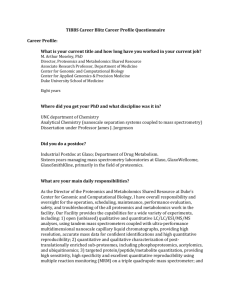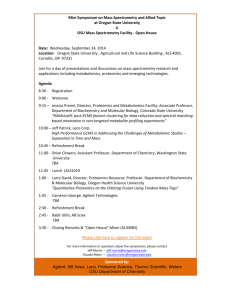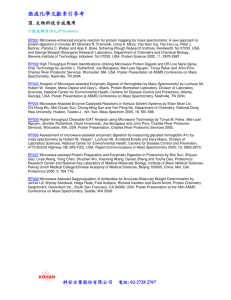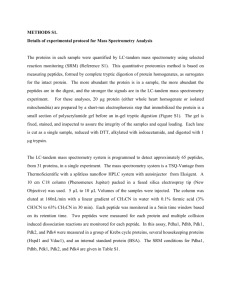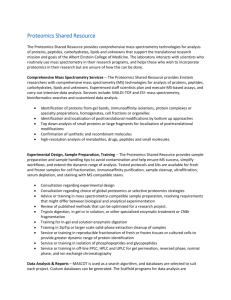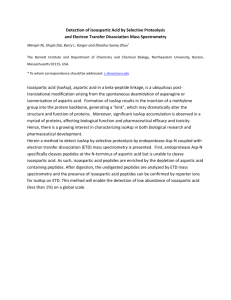Partner Search Form
advertisement
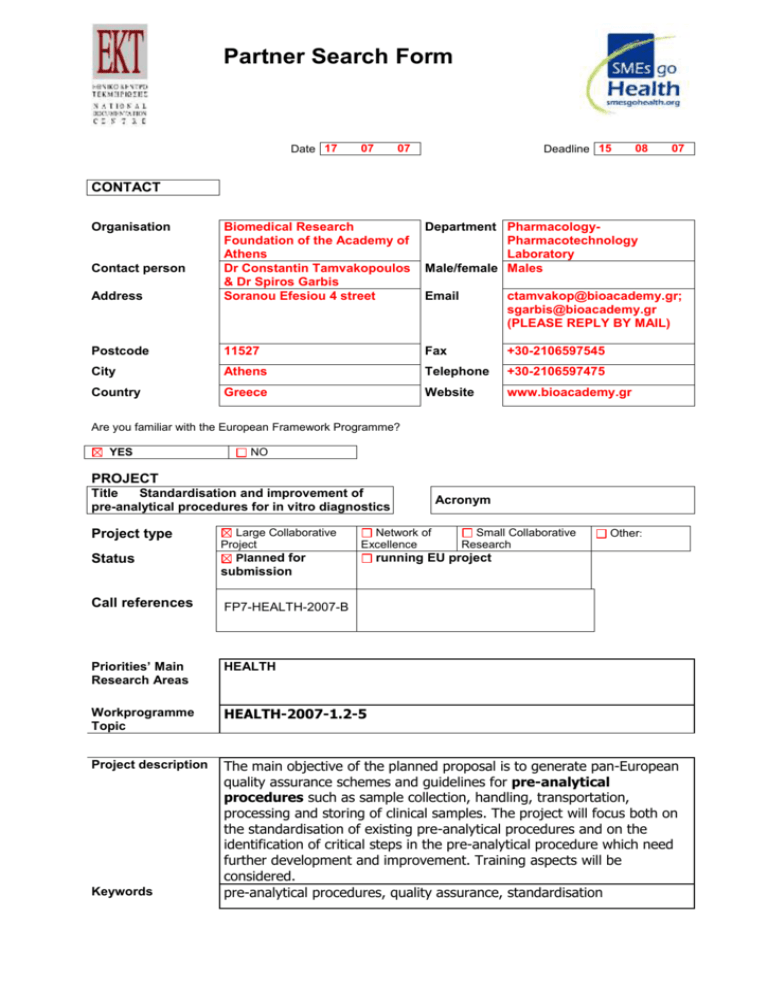
Partner Search Form Date 17 07 07 Deadline 15 08 07 CONTACT Organisation Department PharmacologyPharmacotechnology Laboratory Male/female Males Address Biomedical Research Foundation of the Academy of Athens Dr Constantin Tamvakopoulos & Dr Spiros Garbis Soranou Efesiou 4 street Email ctamvakop@bioacademy.gr; sgarbis@bioacademy.gr (PLEASE REPLY BY MAIL) Postcode 11527 Fax +30-2106597545 City Athens Telephone +30-2106597475 Country Greece Website www.bioacademy.gr Contact person Are you familiar with the European Framework Programme? YES NO PROJECT Title Standardisation and improvement of pre-analytical procedures for in vitro diagnostics Project type Status Large Collaborative Project Planned for Network of Excellence Acronym Small Collaborative Research Other: running EU project submission Call references FP7-HEALTH-2007-B Priorities’ Main Research Areas HEALTH Workprogramme Topic HEALTH-2007-1.2-5 Project description The main objective of the planned proposal is to generate pan-European quality assurance schemes and guidelines for pre-analytical procedures such as sample collection, handling, transportation, processing and storing of clinical samples. The project will focus both on the standardisation of existing pre-analytical procedures and on the identification of critical steps in the pre-analytical procedure which need further development and improvement. Training aspects will be considered. pre-analytical procedures, quality assurance, standardisation Keywords Partner Search Form Partners already involved The Greek partner combines the expertise of two different collaborating laboratories: One in the area of Proteomics (P1A) and one in the area of Pharmacology - Pharmacotechnology (P1B). CONTRIBUTION OF THE GREEK PARTNER Analytical experience and infrastructures (mainly LC-MS systems) to support a variety of studies addressing sample stability and integrity in various complex biological matrices and solvent systems. The molecules with which the teams are involved in include small molecules, peptides, proteins and oligonucleotides. Emphasis on bottom-up Protein Analysis – Quantitative Proteomics – Mechanism of drug action Emphasis on Validation of findings – Absolute Quantification of Proteins and Peptides in biological fluids By Mass Spectrometry Emphasis on the discovery of new therapeutic approaches for the treatment of cancer especially in pre-clinical stages Please note that the Greek participant is not willing to act as Coordinator but will be actively involved in the writing up of the planned proposal. P1A: The Proteomics group is engaged in multidisciplinary research, including several projects on biomarker discovery. The major goal is technology development and transfer to the application of novel approaches in the investigation of human disorders and biological systems. Our group has extensive experience in the protein profiling and relative protein expression analysis of biological samples (tissues, cell culture and body fluids) by two-dimensional gel-electrophoresis (2DGE), multi-dimensional liquidchromatography (MDLC) and advanced mass spectrometry (TOF-TOF, QqTOF and Quadrupole Ion Trap) based proteomics technologies. Areas of interest in the field of cancer specifically include: I) Identification of biomarkers for urogenital cancers (prostate, bladder), II) The proteomic characterization of novel chemotherapeutic/chemopreventive agents. The current Proteomics research efforts incorporate the use of advanced mass spectrometric and sample preparation approaches (sub-cellular fractionation, laser capture microdissection, stable isotope labeling, multi-dimensional liquid chromatography) to assess qualitative (i.e. identity, detection of post-translational modications, determination of protein-protein interactions) and quantitative (i.e. relative expression analysis, protein kinetics, temporal protein changes) attributes within the context of the above on-going projects. P1B: The Pharmacology group is currently focused on the discovery of bioactive compounds (small molecules or peptides) and their efficacy for the treatment of cancer. More recently emphasis has been placed on the role of oligonucleotides for the treatment of cancer. Mass spectrometry plays a key role in our objectives with projects focusing on quantification of small molecules, peptides, and oligonucleotides, questions on metabolism of drugs and mechanisms of drug action. The Pharmacology laboratory is in the process of obtaining ISO17025, with emphasis on the quantitative determination of drugs or biomarkers in biological fluids. The group of Pharmacology has focused on two areas that are relevant to this project: a) The development and validation of sensitive and selective mass spectrometry based methods for the quantification of peptides and proteins by mass spectrometry, b) The discovery and evaluation of novel compounds or improvement of existing therapies for the treatment of cancer. Collaborative studies with groups that have significant Partner Search Form accomplishments in the field of synthesis of bioactive peptides (University of Patras) give our teams access to a wide array of pure peptides that can be used as tools for our research efforts. The role of metabolically stable GnRH agonists for the treatment of cancer is currently being investigated. Answering basic questions related to signaling pathways associated with GnRH agonism or antagonism including inflammation may yield improved therapies for the treatment of prostate cancer. RELEVANT RESEARCH COLLABORATIONS: Relevant project experience: The described team from BRFAA has been on a collaborative project with the Department of Urology and the Department of Pathology, of the Athens University Medical School (Athens, Greece), the Department of Pathology of the Eastern Virginia Medical School (Virginia, USA) and the Chicago Biomedical Consortium (CBC, Illinois, USA) in which clinically traceable tissues and plasma samples have been collected from prostate cancer patients and from patients with benign prostate hyperplasia and are subjected to proteomic assessment in search of biomarkers with greater prognostic and diagnostic specificity and sensitivity relative to the current plasma PSA assay. Additionally, in collaboration with the University of Cyprus, Department of Biological Sciences (Nicosia, Cyprus), molecular biology and proteomic studies are underway to evaluate novel chemotherapeutic-chemopreventive agents in prostate and epithelial cell cultures. The role of such chemopreventive agents in inflammation is of key interest to our lab. The two investigators involved in this effort, Dr. S. Garbis and Dr. C. Tamvakopoulos are confident that the infrastructures and experience of personnel involved are focused and complementary and could yield maximum benefits for this call. This effort would combine four different mass spectrometers (platforms), with distinct niches in proteomics or small molecule research, other infrastructures (see below) and a significant number of technical personnel and trained postdoctoral fellows that could contribute. RESEARCH INFRASTRUCTURE AVAILABLE FOR THE PROJECT Resources - Equipment and Facilities .ISO 17025 and experience/ability to validate and run assays under GLP guidelines. . Animal facility that allows the evaluation of drugs or mechanistic studies in models of cancer research (rodents). The facility is also suitable for other animal models such as rabbits or pigs. Formulation of compounds for in vivo dosing. A bank of more than 30 human cancer cell lines originated from different panels of tumors covering the most frequent forms of the disease allowing the screening of bioactive leads and establishment of xenografts in animal models using NOD/SCID mice. Flow cytometry facility equipped with an FC500 (Beckman-Coulter) FACS with one 488 argon laser and a PARTEC PAs with an HBO lamp and a 488 Argon laser (PArtec GMBh) FACS and a FACSAria cell sorter (Beckton-Dickinson) with a 488 and a 407 solid state laser. . Mass Spectrometry 1. Matrix-assisted laser desorption-ionization tandem time-of-flight mass spectrometer (MALDI-TOF-TOF) with high-throughput and protein sequencing capabilities 2. Liquid chromatography- high resolution quadrupole ion trap tandem mass spectrometry with nano electrospray interface (LC-nESI-QIT MSN). 3. Liquid chromatography- Quadrupole time-of-flight tandem mass spectrometry with a nano-electrospray interface (LC-nESI-QqTOF MS-MS). 4. Liquid chromatography- Tandem mass spectrometry (triple quadruple hybrid with linear ion trap) with Ion Spray interface (LC-MS-MS) ideal for quantitative measurements, small molecule and peptide analysis in biological fluids. Partner Search Form All LC-MS systems are ideally suited for sensitive/selective peptide sequencing and identification of post translation modifications. Software for spot detection and quantification (Melanie-Pharmacia, PD-Quest-Biorad)· . Sample preparation systems: Systems for laser capture microdissection (LCM) Systems for two-dimensional electrophoresis. Systems for liquid chromatography (HPLC, FPLC) Systems for semi- preparative protein electrophoresis (isoelectric focusing and preparative poly-acrylamide gel electrophoresis) Gel scanners Systems for ultracentrifugation SHORT CVs & RELEVANT PUBLICATIONS OF MAININVESTIGATORS (GREEK PARTNER) PARTNER 1A. PROTEOMICS GROUP Dr. Constantin Tamvakopoulos received his B.A. in Chemistry from the University of Chicago in 1986. He continued his studies in the United States and received a Ph.D. in Chemistry/Biochemistry from Brown University in 1992. Following his graduate studies he joined the department of Pharmacokinetics and Drug Metabolism at Purdue Pharma LP (a private pharmaceutical company specializing in drug delivery forms) as a Senior Scientist and then as a Principal Scientist in the same department until 1997. From 1997 until 2004 he held positions at Merck Research Laboratories as a Senior Research Chemist and a Research Fellow in the department of Basic Chemistry. In 2004 he accepted a tenure track position at the Department of Pharmacology, Foundation for Biomedical Research of the Academy of Athens, Athens, Greece. Dr. Tamvakopoulos’ main focus of research revolves around the development and application of novel mass spectrometric techniques with significance in biomedical research, including the discovery and development of new drugs, pharmacokinetics, drug metabolism, quantification of bioactive peptides and bioequivalence studies. By placing emphasis on pharmacokinetic and drug metabolism questions, pharmacologic action can be better understood with beneficial consequences to the design of future therapies. Some of his main scientific contributions as a graduate student at Brown included the development of novel mass spectrometric approaches for the quantification of the intermediates of fatty acid metabolism. The methodology was applied towards the establishment of Acyl-CoA profiles in patient fibroblasts with inherited metabolic diseases, in collaborative studies with the Children’s Hospital in the University of Pennsylvania.During his seven years at Merck Dr. Tamvakopoulos collaborated with synthetic chemists, biologists, pharmacologists in many new drug discovery programs in the therapeutic areas of metabolic disorders (obesity, diabetes), inflammation (arthritis) and atherosclerosis and actively participated towards the advancement of new leads in the various drug discovery programs. Some of those leads have now advanced to phases of clinical development by Merck. In the pharmaceutical industry, Dr. Tamvakopoulos, his group and colleagues contributed to the research and development work (execution of clinical pharmacokinetic and drug metabolism studies) that lead to the approval of successful new drugs to the market for the treatment of pain and type-II diabetes. Selected publications/presentations 1.) Trivedi P, Jiang M, Tamvakopoulos C, Shen X, Yu H, Mock S, Fenyk-Melody J, Van der Ploeg LH, Guan XM. (2003) Exploring the site of anorectic action of peripherally administered synthetic melanocortin peptide MT-II in rats. Brain Res. 977, 221-230. 2.) Zhu L, Tamvakopoulos C, Xie D, Dragovic J, Shen X, Fenyk-Melody JE, Schmidt K, Bagchi A, Griffin PR, Thornberry NA, Sinha Roy R. (2003) The role of dipeptidyl peptidase IV (DP-IV) in the cleavage of glucagon family peptides: in vivo metabolism of pituitary adenylate cyclase activating polypeptide [1-38]. J Biol Chem. 278 (25), 22418-23. 3.) Tamvakopoulos C, Dimas K, Sophianos ZD, Han Z, Wyche JH, Pantazis P. The Curcumin Analogue, Dimethoxycurcumin: Apoptosis Induction of Cultured Human Colon Cancer Cells, Metabolism in Liver Microsomes, Stability in Cultured Cells, and Plasma Concentrations in Mice. Clin Cancer Res. 13(4):1269-77. 4.) Tamvakopoulos C. (2007) Mass spectrometry for the quantification of bioactive peptides in biological fluids. Mass Spectrom Reviews, 26 (3): 389-402. 5.) Hatziieremia S, Kostomitsopoulos N, Balafas V, Tamvakopoulos C. (2007) A liquid Partner Search Form chromatographic/tandem mass spectroscopic method for quantification of the cyclic peptide melanotan-II. Plasma and brain tissue concentrations following administration in mice. Rapid Commun Mass Spectrom. 21, 2431-2438. PARTNER 1B. PHARMACOLOGY GROUP Dr. Spiros D. Garbis received his BSc degree in Chemistry from the University of Illinois in 1989. As a research chemist he worked at Honeywell Zellweger Analytics in the area of environmental toxicology using remote sensing molecular spectroscopy technologies from 1990-1995. He later worked as a forensic scientist at the Animal Forensic Toxicology Laboratory of the University of Illinois, Department of Biopharmaceutical Sciences from 1994 – 1998 where he developed and applied methodologies based on bioanalytical mass spectrometry (MS) techniques in the determination of xenobiotic substances and their metabolites in biological fluids and tissues. His exposure in the area analytical toxicology prompted him to pursue doctoral training under the mentorship of Prof. Dr. Richard B. van Breemen at the University of Illinois, Department of Medicinal Chemistry and Pharmacognosy from 1998 – 2003 where he received his PhD in 2003 in the area of Molecular and Biochemical Toxicology. His studies involved the use of MS based proteomic and metabonomic approaches to the study of the bioavailability, biotransformation and bioequivalence properties of folate species in humans. As a tenure track research chemist at IIBEAA, Center for Basic Research, Biotechnology Division, Dr. Spiros D. Garbis is involved in the development and application of novel liquid chromatography – tandem mass spectrometry (LC-MS) techniques in the characterization of peptides and proteins in biological samples. In order to accurately address complex biological processes, he is currently involved in the method development and application of methods combining the use of multiplex stable isotope labeling techniques (i.e. iTRAQ, SILAC, and others) and multi-dimensional LC-MS platforms in the discovery and characterization of novel, mechanism-based protein biomarkers with prognostic and diagnostic potential in prostate cancer treatment (including the proteomic evaluation of natural product chemical analogs both as chemotherapeutic-chemopreventive agents and as «chemical probes» for biomarker effectiveness). As such, he has established in-house capabilities for the preparation of custom capillary columns utilizing advanced chromatographic chemistries to be used in combination with various MS architectures including nano-electrospray-quadrupole time-of-flight, ion trap and matrix assisted laser desorption tandem time-of-flight instrumentation. In addition, he is currently involved in the design and application of integrated lab-on-a-chip devices in collaboration with Democritos. Such devices hold promise in increasing analysis throughput and sensitivity for the MS based determination of low abundance biomolecules in complex biological matrices. Selected Publications 1. Garbis S., Lubec G., Fountoulakis M. (2005). Limitations of current proteomics technologies. J. of Chromatogr. A 1077, 1-18. 2. Kouyianou K., Garbis S.D., Boulias K., Dimitraki P., Talianidis I., Fountoulakis M., Tsiotis G. (2006) Proteomic analysis of liver from transgenic mice overexpressing small heterodimer partner. Cancer Genomics and Proteomics. 3, 119-126. 3. Tsangaris G.T., Karamessinis P., Kolialexi A., Garbis S.D., Antsaklis A., Mavrou A., Fountoulakis M. (2006) Proteomic analysis of amniotic fluid in pregnancies with Down syndrome. Proteomics. 6, 4410-4419. 4. Giannopoulou E.G., Garbis S.D., Vlahou A., Kossida S., Lepouras G., Manolakos I. (2007) Proteomics Feature Maps Using Spheres. Proteomics. Submitted-manuscript: proteo-2007-00352. 5. Garbis S.D. et al (2007). Quantitative proteomic determination of potential cancer biomarkers in prostate tissue derived from a human pilot clinical study. J. of Prot. Res. Manuscript in preparation. Project budget (for the running projects) Budget reserved for SMEs Partner Search Form Profile of Partner sought Role Country /region Start of partnership Expertise required technology development research training dissemination demonstration other: mid-term end-phase All countries except Greece start-up phase Academia, industry and SMEs with relevant expertise in pre-analytical procedures for in vitro-diagnostics. I agree with the publication of my data PLEASE FILL IN THE PARTNER SEARCH FORM AND RETURN IT TO: Dr. Cristina Pascual, National Documentation Centre, e-mail: cpascual@ekt.gr

